Hangzhou's low carbon initiatives empower high-quality development
The "Hello, Carbon Neutrality" research group, comprising more than 20 central media reporters, foreign experts, and international students, recently traveled to Hangzhou, east China's Zhejiang Province. They sought to delve into the city's endeavors for a green, low-carbon transformation and to gain insights into the experiences gained in creating a low-carbon city.

The "Hello, Carbon Neutrality" research group visits Hangzhou Wulin Night Market. [People's Daily Online/Wang Liwei]
The research group first visited the bustling Hangzhou Wulin Night Market. Douglas Dueno, a U.S. foreign expert for China Daily, said, "The Wulin Night Market is vibrant, and the air is filled with the aroma of various types of food. Countless stalls full of diverse goods entice tourists to browse and shop. I was deeply impressed by the traditional handicrafts and the spectacular performances of street performers."
However, beyond Hangzhou's deep-rooted history, culture, and dynamic night economy, what caught Dueno's attention was the city's commitment to low-carbon development.
The city of the Asian Games pursues green development
Hangzhou, set to host the Asian Games in September, is pursuing green development. On June 16, the Olympic Council of Asia donated various sculptures to the Hangzhou Asian Games Museum. Notably, this is the first Asian Games Museum to be open to the public before the Games officially begin.
On June 27, the research group visited the Hangzhou Asian Games Museum, which boasts an exhibition area of 5,400 square meters. The museum aims to be an immersive interactive center showcasing the history of the Hangzhou Asian (Paralympic) Games, the history and cultural exchanges of the Asian Games, and the vitality and charm of sports life. The research group visited three exhibition halls, namely "Asian Games and Hangzhou," "Asian Games and Asia," and "Asian Games and the Future."
The sculptures of the Hangzhou Asian Games mascot, "Memories of Jiangnan," the torch wall from previous Asian Games, and the mascots of past Asian Games displayed in the museum captivated the group members, prompting them to pause and observe. The engaging exhibits provided an immersive experience for visitors.
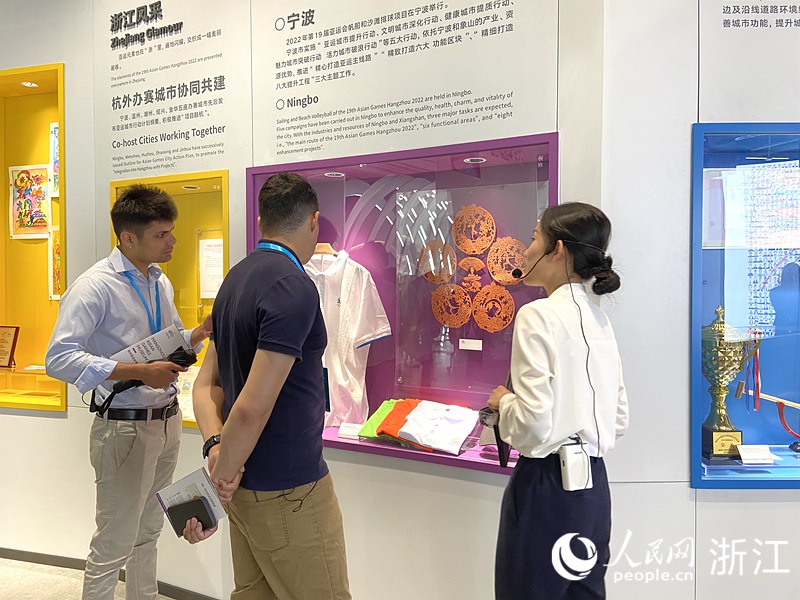
The "Hello, Carbon Neutrality" research group visits the Hangzhou Asian Games Museum. [People's Daily Online/Fang Pengyimeng]
"The design of the museum is beautiful. The content displayed is very professional. It introduces the development of Asian sports and the process of bidding and organizing the Hangzhou Asian Games," said Ha Jung Mi, a South Korean reporter for People's Daily Online.
On display were also four models representing the core venues of the Hangzhou Asian Games. The Asian Games venues are known to have been planned in three distinct types: reconstruction, temporary construction, and new construction. This was done in accordance with the philosophy of "reconstructing instead of building, repairing instead of replacing, renting instead of buying," aimed at minimizing the environmental impact of the Games.
Dueno commented that the Hangzhou Asian Games have set an exemplary standard, particularly in their green, smart and sustainable practices, which other Asian countries should learn from.
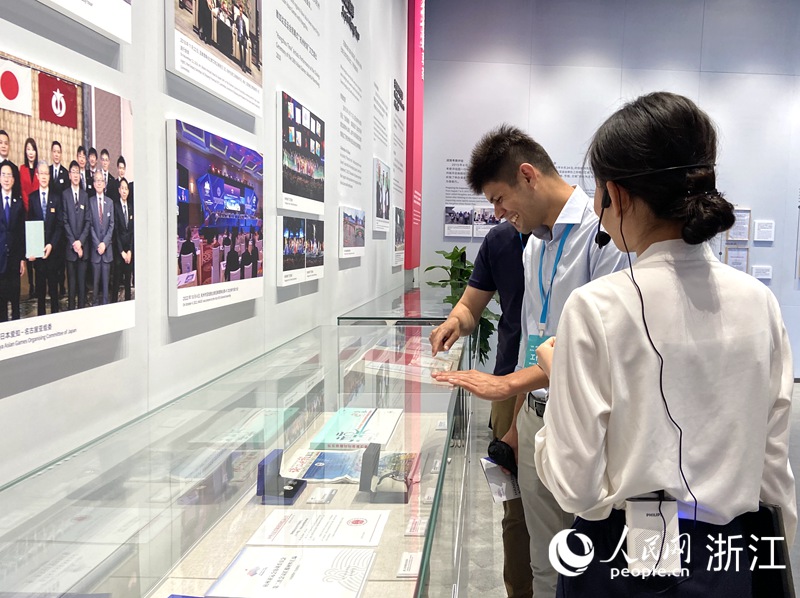
The "Hello, Carbon Neutrality" research group visits the Hangzhou Asian Games Museum on June 27, 2023. [People's Daily Online/Fang Pengyimeng]
"The Hangzhou Asian Games have fully integrated the green and low-carbon concept into the whole life cycle, including the stadiums' construction, operation, management, and utilization after the competition," said Sarah Mary De Meillon, a South African student at Huaqiao University.
Digitalization empowers carbon neutrality
On June 27, the research group visited the Zhejiang Energy Big Data Center.
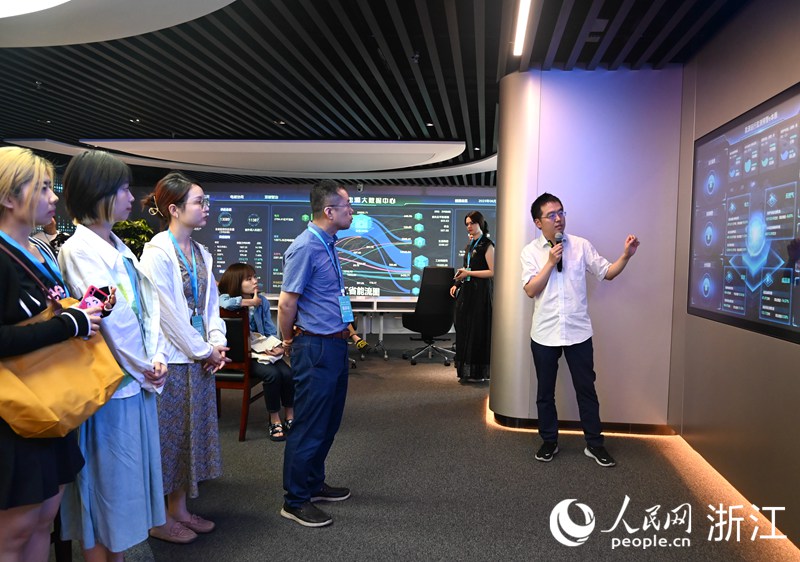
The "Hello, Carbon Neutrality" research group visits the Zhejiang Energy Big Data Center. [People's Daily Online/Fang Pengyimeng]
Based on power, energy, and carbon emissions data, the data center explores the interplay between electricity, energy and carbon. It features a carbon emissions accounting model with industry segmentation, offering a "carbon perspective" for energy conservation and emissions reduction. This creates real-time carbon "business cards" for 47,000 enterprises, 2,168 key projects, and over 430,000 individuals in the form of carbon credits. This essentially gives each entity a "carbon ID card," laying the groundwork for upgrading the economic and industrial structure.
"Breaking down inter-departmental 'data barriers' and achieving the sharing and integration of 39 types of data from various departments and levels is quite remarkable," exclaimed Khian Artgold Bonsobre, a Filipino student at Huaqiao University. "Digital applications like the 'dual carbon digital intelligent platform,' 'e-accounts for energy saving and carbon reduction,' and 'carbon efficiency code' have been instrumental in facilitating the precise implementation of the 'dual carbon' goals."
Hangzhou's digital innovation journey also involves storing green power to facilitate peak carbon emissions and carbon neutrality.
On June 27, the research group visited the State Grid Hangzhou Power Supply Co., Ltd. and received a briefing about the "Hangzhou Dual Carbon Digital Intelligent Platform" at the Hangzhou Energy Big Data Evaluation and Application Research Center.
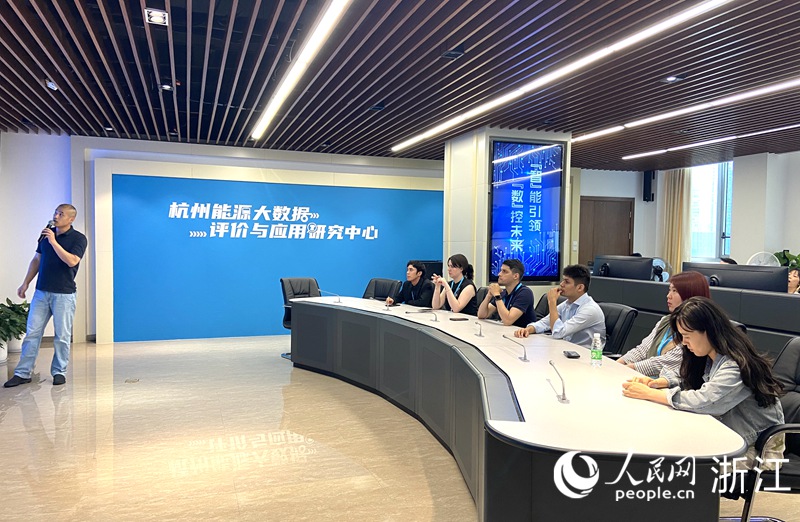
The "Hello, Carbon Neutrality" research group listen to a briefing about the "Hangzhou Dual Carbon Digital Intelligent Platform" at Hangzhou Energy Big Data Evaluation and Application Research Center. [People's Daily Online/Fang Pengyimeng]
The platform, which began trial operations in September 2021, provides digital and intelligent supervision for more than 2,390 industrial enterprises with annual energy consumption exceeding 1,000 tonnes of standard coal, and public buildings with annual power consumption exceeding 1 million kilowatt hours in Hangzhou.
"Technological innovation is a key step in reducing carbon emissions. In the digital era, the construction of a green, low-carbon circular economy cannot be done without digital technology," said Ha. She added that in Hangzhou, the low-carbon transition has made notable progress. As a "digital city," Hangzhou leverages digital technology to advance the "dual carbon" goals, achieving impressive results.
Green energy drives low-carbon transformation
In its quest to continue leading the green and low-carbon energy transformation and to strengthen independent energy security, Hangzhou has sped up the construction of centralized photovoltaic power station projects.
On June 27, the research group visited Hangzhou Qiantang Zero Hydrocarbon Coupling Park.
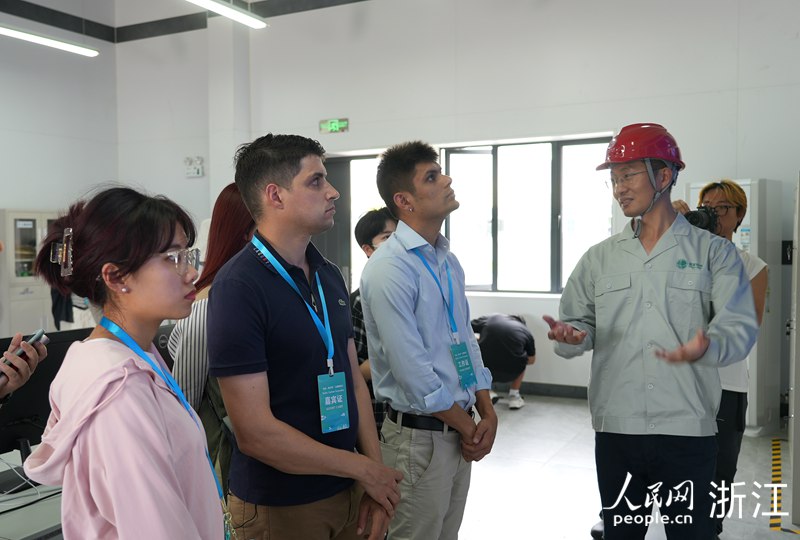
The "Hello, Carbon Neutrality" research group visits Hangzhou Qiantang Zero Hydrocarbon Coupling Park. [People's Daily Online/Fang Pengyimeng]
"Qiantang district in Hangzhou, where the park is situated, is home to industrial enterprises highly motivated towards a low-carbon and green transition,” said Tu Yongwei, director of the Operation and Maintenance Department at State Grid Hangzhou Qiantang Power Supply Co., Ltd. “Consequently, we spearheaded the construction of the country's first flexible DC hydrogen-electric coupling 'zero carbon' park. This initiative aims to surmount the challenges in transforming and applying key trusted technologies that utilize renewable 'green electricity' to generate 'green hydrogen,' thereby contributing to China's 'green manufacturing,'" he added.
In Qiantang district, the research group also studied the regional centralized energy supply project focused on renewable energy.
The project is a model for energy conservation and carbon reduction. It encompasses two primary scenarios, industrial and urban, of which the industrial energy supply project has been implemented in Hangzhou Medicine Town. Upon completion of the fourth site, the regional centralized energy supply system will serve approximately 1 million square meters of regional industrial buildings.
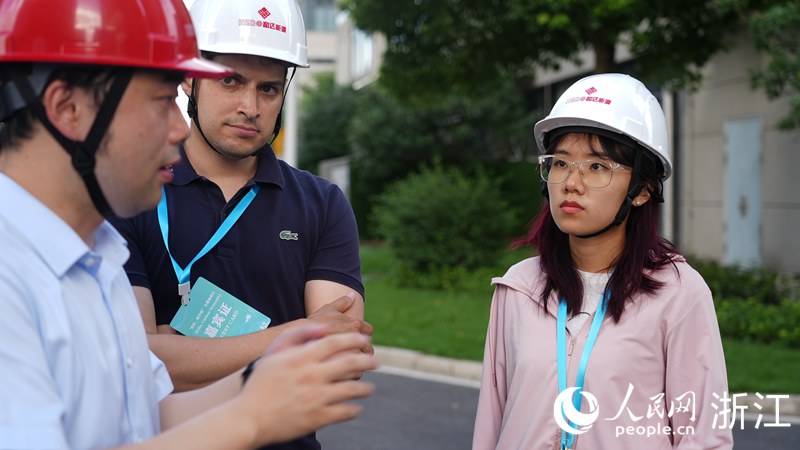
The research group visits and investigates the regional centralized energy supply project of Qiantang renewable energy. [People's Daily Online/Fang Pengyimeng]
The project integrates photovoltaic panels and buildings. "This is so cool," said Dueno. "Through the combination of photovoltaic modules and insulating glass, the photovoltaic curtain wall not only maintains the original functional, safety and aesthetic needs of the building, but also provides electricity through year-round power generation. Meanwhile, the heat energy converted by solar energy can also meet the seasonal energy needs of the building."
On June 28, the "Hello, Carbon Neutrality" research group visited Xiaoshan Power Plant and its electrochemical energy storage power station project. The project is an independently managed, large-scale electrochemical energy storage power station. It utilizes leftover space from retired coal-fired units at Xiaoshan Power Plant. By storing and releasing energy, the power station can save a significant amount of off-peak electricity for peak hours.
"We learned that the power station is independently dispatched by the grid and can provide a variety of power services such as fast and flexible peak regulation, frequency modulation, phase modulation, backup, and black start for the grid," said Dueno, praising the project.
As a "giant portable charger," Xiaoshan Power Plant's electrochemical energy storage power station will play a crucial role in the power conservation of the Hangzhou Asian Games.
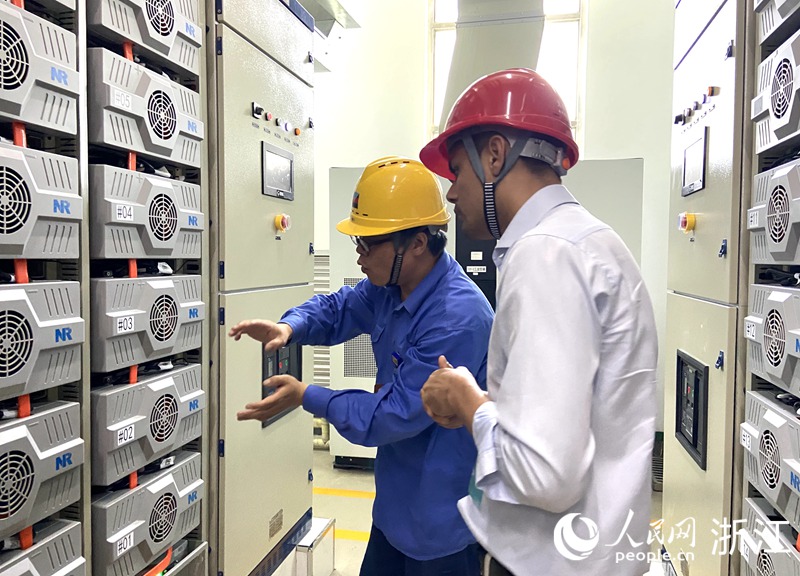
An employee at Xiaoshan Power Plant talks to a group member. [People's Daily Online/Fang Pengyimeng]
On the same day, the group also learned how new energy vehicles can quickly swap their batteries at Sinopec Hangzhou Yangjiadun Energy Station. This is the first battery-swapping station built by the Zhejiang Petroleum Branch of Sinopec and NiO Automobile.
"This power station amazes me because battery changes can be as easy as refueling," said Revachand, a Pakistani student at Beijing Foreign Studies University.
Under China's "dual carbon" goals, state-owned enterprises are striving to lead in green and low-carbon development. In recent years, the Zhejiang Petroleum Branch of Sinopec has followed contemporary trends, closely focusing on the industrial pattern of "consolidating the clean oil product and modern chemical industry, exploring new energy, new material, and new economy, based on energy resources." The company continues to accelerate the creation of comprehensive "oil, gas, hydrogen, and electric" energy service stations, leading the development of the energy industry. It has developed 64 gas stations, 282 charging and battery-swapping power stations, seven hydrogenation stations, and 194 distributed photovoltaic projects.
"I heard about hydrogen energy through news reports, but seeing it with my own eyes was much more vivid. I think the hydrogen energy market has a bright future, and I look forward to its popularization," Ha said.
Incorporating low-carbon solutions into daily life
The countryside serves as a fundamental part of social development. The overall progress towards a low-carbon society also depends on the actions taken within rural areas. Seeking answers to the question, "How can we live a low-carbon life in the countryside?" the research group visited Meilin village in Xiaoshan district, Hangzhou.
Following the goal of building low-carbon countryside, Meilin village centers its attention on two main facets of future energy and lifestyle. The village has constructed five application scenarios: future factories, future residences, future travel, future stations, and future buildings.
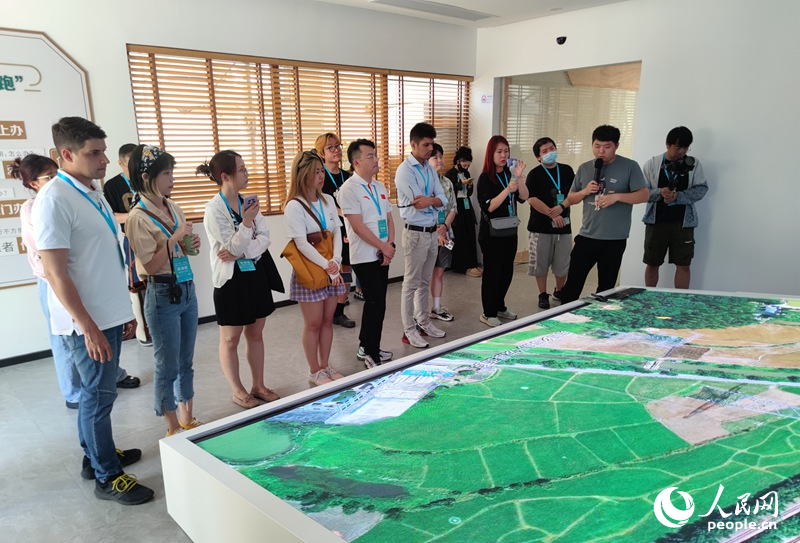
The "Hello, Carbon Neutrality" research group visits Merlin village. [People's Daily Online/Wang Pu]
"It's great that villagers can install photovoltaic panels on the roofs to insulate their homes, which are beautiful and can create green revenue at the same time. In Meilin village, I experienced the great changes that have taken place in rural China. People living here must be very happy," Bonsobre said.
The research group also visited the Low Carbon Technology Museum in Hangzhou. This expansive science and technology museum, themed around low-carbon initiatives, doubles as a supplementary classroom for the public, especially young people, to learn about a low-carbon lifestyle, city and economy.
Guided through the museum, the research group viewed many low-carbon devices on display. The members of the group immersed themselves in well-designed scientific games, acquired a wealth of knowledge on carbon neutrality and carbon peaking, and familiarized themselves with the efforts and methodologies of Hangzhou Low-Carbon Science and Technology Museum in disseminating low-carbon technology, showcasing green buildings, spreading low-carbon knowledge, and assisting in the creation of low-carbon cities.
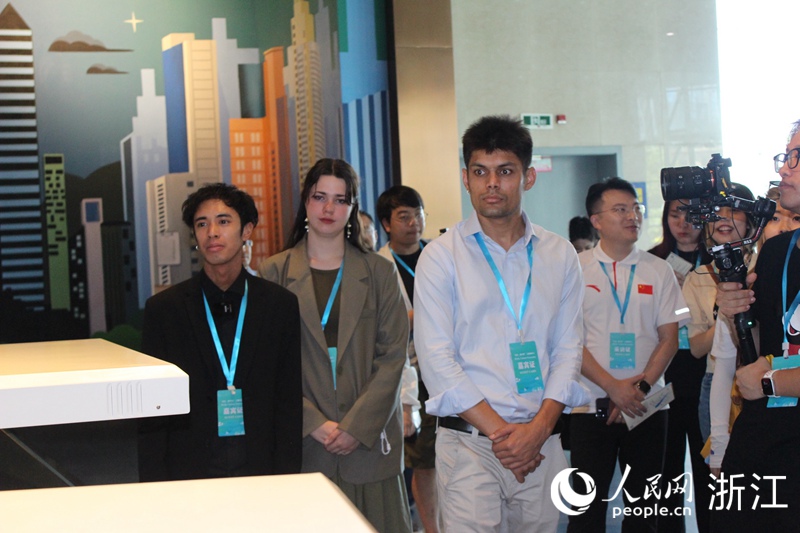
The "Hello, Carbon Neutrality" research group visits Hangzhou Low-carbon Science and Technology Museum. [People's Daily Online/Fang Pengyimeng]
Ha stated that Hangzhou had established a new trend in green and low-carbon development. By showcasing Hangzhou's construction experiences and typical cases of carbon peaking and carbon neutrality, China's "dual carbon" goals are progressively transforming from an abstract concept into a myriad of tangible actions and stories.
























